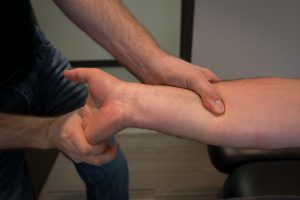The fascia’s ability to limit tissue functionality can be thought of like the ability of the emergency brake to restrict the function of a car… it may look like an engine or drive-train issue, but take the brake off and away you go! Many therapies focus on only treating certain parts such as the “engine” (muscle), but how much horsepower, torque, and gas ecomomy can you expect if you’re driving with the brake on? Fix the fascia problems first, many patients will tell you that they were not as weak or easily muscle fatigued as they thought! It should make good sense that if a number of muscles are adhered to each other that you’ll never get perminently rid of the recurrent knot/ache/pain until you free up the source of the irritation.
What is an A.R.T.® Treatment Like?
 A.R.T.® sessions are always a combination of soft tissue evaluation and subsequent treatment. A.R.T.® therapists use palpation (their hands) to evaluate the tone, texture, stiffness, and movement of all relevant soft tissues (muscles, fascia, tendons, ligaments, nerves, etc). Any soft-tissues that are noted as moving abnormally are then treated by a combination of anatomically precise tension and very specific patient movements. It is this specificity that allows the practitioner to develop an individualized treatment for every patient’s condition(s).
A.R.T.® sessions are always a combination of soft tissue evaluation and subsequent treatment. A.R.T.® therapists use palpation (their hands) to evaluate the tone, texture, stiffness, and movement of all relevant soft tissues (muscles, fascia, tendons, ligaments, nerves, etc). Any soft-tissues that are noted as moving abnormally are then treated by a combination of anatomically precise tension and very specific patient movements. It is this specificity that allows the practitioner to develop an individualized treatment for every patient’s condition(s).
As A.R.T.® continues to evolve there are now over 500 specific treatment protocols unique to this technique. Unlike many modalites of soft tissue treatment, A.R.T.® is not a “paint-by-numbers” approach; it requires significant time and dedication on the part of the therapist to learn and work toward perfecting.
What is the History of Active Release Techniques®?
A.R.T.® has been invented, refined, and susequently patented by Dr. P. Michael Leahy, DC, CCSP. Dr. Leahy used his considerable knowledge of engineering/physics applied to anatomy and physiology to understand how soft tissue injury/repair complicated body movement. Over decades of dedicated study and practice, he as brought A.R.T.® to it’s current levels of Gold Standard soft tissue treament. Due to his efforts, many conditions that prieviously would have been considered permanent/untreatable have now been rendered “fixable”. Dr. Leahy still practices in Colorado Springs, CO, USA and dedicates much of his time to teach and certify health care providers all over the world to use A.R.T.®.
 A.R.T.® is a technique which focuses on soft-tissue movement using palpation/hands-on diagnosis. It is considered a state of the art soft tissue system due to its extreme specificity in the treatment of problems with muscles, tendons, ligaments, fascia and nerves.
A.R.T.® is a technique which focuses on soft-tissue movement using palpation/hands-on diagnosis. It is considered a state of the art soft tissue system due to its extreme specificity in the treatment of problems with muscles, tendons, ligaments, fascia and nerves.
 A.R.T.® sessions are always a combination of soft tissue evaluation and subsequent treatment. A.R.T.® therapists use palpation (their hands) to evaluate the tone, texture, stiffness, and movement of all relevant soft tissues (muscles, fascia, tendons, ligaments, nerves, etc). Any soft-tissues that are noted as moving abnormally are then treated by a combination of anatomically precise tension and very specific patient movements. It is this specificity that allows the practitioner to develop an individualized treatment for every patient’s condition(s).
A.R.T.® sessions are always a combination of soft tissue evaluation and subsequent treatment. A.R.T.® therapists use palpation (their hands) to evaluate the tone, texture, stiffness, and movement of all relevant soft tissues (muscles, fascia, tendons, ligaments, nerves, etc). Any soft-tissues that are noted as moving abnormally are then treated by a combination of anatomically precise tension and very specific patient movements. It is this specificity that allows the practitioner to develop an individualized treatment for every patient’s condition(s).